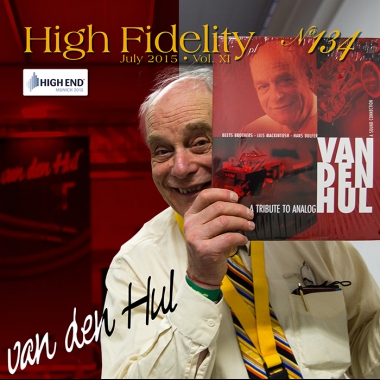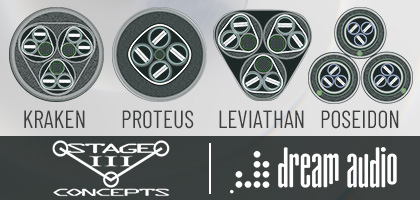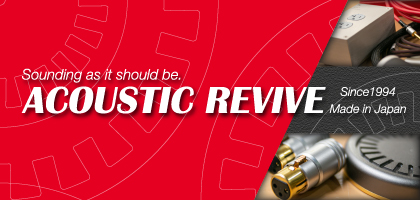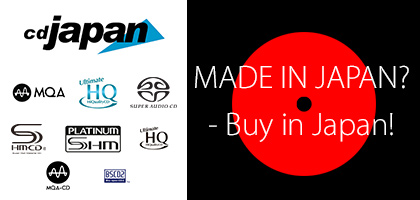No. 260 January 2026
- COVER REVIEW: EVERSOLO DAC-Z10 ⸜ digital-to-analog converter/preamplifier » CHINA
- AWARDS: BEST OF 2025 according to the HIGH FIDELITY » WORLDWIDE
- KRAKOW SONIC SOCIETY № 154: CRYSTAL DISC • AudioNautes Recordings » ITALY - JAPAN - POLAND
- REVIEW: FEZZ AUDIO Luna Mini Evo ⸜ integrated amplifier » POLAND
- REVIEW: GARLUBIDOR Divinity ⸜ digital-to-analog converter » CHINA
- REVIEW: XAVIAN Natura Unica ⸜ loudspeakers • stand-mounted » CZECH
- MICRO-REVIEW: ACOUSTIC REVIVE QSB-3810 ⸜ spike pads » JAPAN


|

|
|
TAPES OF TRUTH 
Schlumberger Digitech SA F500 reel-to-reel tape recorder, with Diana Krall's tape next to it. High End Show 2015 in Munich. From the late XIX century, when we started to manipulate the most basic elements of the universe, starting with electrons, human life has been changing rapidly. One of the indicators of how quick these changes are is the fact that just a hundred years ago – even before Marconi introduced his telegraph and Edison his phonograph – the only way to listen to the music was to listen to live performance. Today live music is just a friction of a per cent of music that we listen to. All the rest is reproduced or broadcast with electronic devices together with billions of words and images everyday.
HISTORY The story of a turntable started in the 19th century. In 1877 Thomas Edison (11.01.1847 – 18.10.1931) patented his invention he called: PHONOGRAPH. This was a devices that allowed him to record and later play back sound. Medium was a tinfoil sheet phonograph cylinder. Three years later Alexander Graham Bell „upgraded” Edison's invention and instead of tin foil he used wax. He called his device: GRAPHOPHONE. This type of device was manufactured in the 1880ties, and used as sort of dictaphone, or were placed in so called phonograph parlors, where customers would sit at a desk where they could speak through a tube, and order a selection for one nickel. Through a separate tube connected to a cylinder phonograph in the room below, the selection would then be played. Due diligence tell us to mention that the first known sound recording device was called PHONAUTOGRAPH, and that it was patented in March 25th 1857 in France by Édouard-Léon Scott de Martinville (25.04.1817 – 26.04.1879). His invention wasn't very practical though, as it only recorded sound, but there was no way of playing the recorded information back. The song he recorded, Clair de Lune, was actually played for the first time in 2008, so only 150 years later. Gramophone Phonograph recorded signal to a tinfoil cylinder that was also used to play the signal back. This mean that there was no intermediary medium between recording and playback. That is also how gramophone worked. The very first machine was patented in 1892. It was developed by Emil Berliner. This German emigrant, at the time already living in USA, worked on his machine for 7 years. Instead of cylinder he decided to use a flat record surface that was more comfortable to use, and more durable. He decided to call his machine a GRAMOPHONE. In this case sound was recorded to acetate that was used later to prepare matrix used to press firstly shellac, 78,26 r.p.m. Records and after 1931 Long Play (33,3 rpm) ones, invented by Columbia (12”). The LP vinyl record as we know it was introduced in 1948, and a year later RCA released first 45 rpm (7”) singles. 
A wonderful, tiny Nagra IV S with external module for larger reels. Module sports two additional motors. High End Show 2015 in Munich. Most of the recordings made prior to 1950 are direct-to-disc ones. Today this method is considered to be the most accurate one, as demonstrated, for example, by Sheffield Lab, but also as the least practical one. The recording had to be performed in one non-stop session and no editorial job was possible with such recording. To make editing possible another medium was required, one that would allow recording and deleting signal, that would also be re-writable, and that would allow adding more information to already recorded one. So in fact what music industry needed was a TAPE RECORDER. Tape recorder As you already know the first commercial techniques of recording and playback of the sound were developed in USA. But the first inventions have German roots. In Europe, in France to be exact, a phonograph was introduced only 3 month after its American premiere, and the first Berliner's records were pressed end of 19th century. That's when British company Gramophone Co. started their record pressing plant in Hannover. In Berlin, Berliner's family started a branch called Deutsche Grammophon A.G., that for many years has been a leading classical music label. Let's get back to the tape recorder. Already in 1878 Edison experimented with magnetic forms of recording on a steel foil. Another idea was a “magnetic” ink (a liquid with microscopic iron particles), and later a cotton thread with steel particles attached to it. From this idea it was far to magnetic wire recorders. The first wire recorder was the Valdemar Poulsen, Danish national, Telegraphone of the late 1890s. In this device magnetized wire moved with a constant speed past a recording head. At the beginning it was used as a dictaphone - just like Edison's phonograph – and it was produced mostly in 1920s and 1930, but it wasn't very popular. Still, in USA, this technology was developed until 1950s. Today we know all these inventions only from museums. What beat them all was a magnetic tape recorder, another invention that came from Germany. Leopold B. Witkowski wrote in his book, that a real sensation was during Berlin radio exhibition in 1935 was caused by a device called MAGNETOPHON – a result of common experiments conducted by BASF and AEG (Leopold B. Witkowski, O stereo i kwadrofonii, Warszawa 1990, p. 118).First 50 km of tape Fabrik-BASF manufactured a year before that. 
Nagra IV S, basic version with regular, small reels. A perfect condition unit can be bought on eBay for around 10 000 PLN. High End Show 2015 in Munich. When the Second World War started the whole project run by Germans (of improving sound quality) was classified – since that moment works were supervised by Army authorities. During II WW the Allies noticed that sound quality of German radio transmissions significantly improved. After Radio Luxembourg was seized by Allied Force an unknown tape recorder type was found there. The device was sent to USA where it caught attention of Minnesota Mining and Manufacturing Co., today called simply 3M. It turned out that this excellent sound quality was achieved due to a technique that, as rumor had it, was invented by a pure accident. A key to recording technique as we know it today, was using a bias, i.e. adding to a signal another, high frequency one (50-100 kHz), that initially magnetized tape. Shortly after that also Ampex and British EMI (BTR) proposed their models of tape recorders. These were cornerstones for the modern recording techniques, that shaped (literally) the world of recorded music for the next 60 ears. 
Ferrograph Logic 7 reel-to-reel recorder. High End Show 2015 in Munich. Tape recorders are not very user-friendly mostly because of all sorts of problems with tapes. Tapes themselves have always been (and still are) expensive and copying them was problematic. No wonder that mass customer preferred to use a turntable as a primary source of sound. And it is a turntable that today is considered to be a top performance source for audiophile systems. But even within such a small market niches as ours (to be honest in 1950-1980 it was surely bigger than now) there are even smaller ones. Tape recorders have had such a tiny niche for years and today one might observe what could be called a come back (on smaller scale than turntables) to some audiophile systems. TAPE VS RECORD Assuming record's supremacy over other types of music mediums one forgets about everything that happens before signal is written into the record. It's like the tape, that for years was used almost exclusively by professional side of audio world, was the other, unreachable side of a mirror for audiophiles (I mean a classic situation with analogue recording). And yet the original source of signal is so called mother-tape (master-tape) with the material that was recorded, edited and prepared to be replicated on other mediums – LPs, cassettes, CDs and others. |
The reappearance on audiophile market of reel-to-reel recorders and tapes that were copies of 2. or 3. generation mother-tapes created new opportunities. First of all it became easier to compare, sometimes even the same material played from a reel-to-reel tape and a record. If you had a chance to witness to such a head-to-head comparison you'd probably admit that these two medium offered quite different sonic characteristics. Despite the fact that in both cases these were analogue mediums, original and copy. For me the main differences are the way of soundstage presentation, tonality and dynamics. 
Beautifully restored Studer B 62 Master with additional panel with VU-meters, made by Eternal Arts. Soundstage delivered by a reel-to-reel does not have clear boundaries nor layers. First listening session with such tape might be a shock to people used to a different presentation offered by LPs or CDs that are more selective, that present each instrument in a more distinctive way. Tape delivers more condensed picture, meaning – it presents rather groups of instruments that move and shine together. Basing on that information our minds interpret spacial order. Other mediums seem to deliver spacial order that is already a least partially fixed on the soundstage. 
Stellavox reel-to-reel, battery powered, presented on Horh House stand during High End Show 2015 in Munich. The very unfortunate approach used in audio for many years claimed that the more detailed sound the better. As a result of such approach most ultra-high-end systems were, in my opinion, a complete failure. Bright sounding, extremely detailed, deprived from emotional side of music, tiresome. Music played from a reel-to-reel shows us a different way. Sound is quite dark, I'd say. It is also amazingly resolving, and I mean an unparalleled level of resolution, and yet this sound is not particularly detailed. That's because details are only one of many elements of the presentation, one that does not attract too much attention. Presentation is more about information, harmonics, also harmony between all elements. And finally dynamics – one can not achieve such dynamics from a record. The way music is presented is almost indescribable as it can't be compared to what we know from LP and CD, as the dynamics from a tape is very similar, although not identical, to what we know from live performances. That's also sort of approximation, but it makes it easier to understand what I'm talking about. All other mediums seem, in comparison, dynamically flat, compressed. TAPE VS DSD So it seems that the best choice for ultimate system is a reel-to-reel tape recorder. And then spend 250-350 EUR per tape or two, when it comes to 38 m/s speed recordings, and even four (for 600 EUR), when it comes to double albums. As for the deck itself – it should be something like Studer A80, a model used by Dirk Somner and Jacek Gawłowski, who remastered (among other things) Czesław Niemen's albums. That's a device of a size of large commode, only deeper. When you think about it, it is hard to imagine using such a big device and paying that much for tapes and yet, there are some high end systems with reel-to-reel main source. Most of them use smaller machines like the ones from Nagra Stellavox, ReVox, TEAC, Denon, Pioneer or Sony. These are good, but not as good as above mentioned Studer 80. 
Tapes from Columbia and Polydor. High End Show 2015 in Munich. I've been getting the same feedback from different people dealing with analogue remastering recently that indicates something new and interesting. Damian Lipiński (DALI Records), who does some work for Polskie Nagrania (like new remasters of Perfect and Dżem albums), did some tests in his studio and he unambiguously claimed that it was a DSD format that offered quality closest to the one of analogue master-tape. I heard the same from Dirk and some other friends who do work in mastering studios. They all point out a better, more convincing tonality, especially in bass range and lack of a specific euphony audible with PCM files. The latter seem also unnaturally detailed and hyper-resolving. That describes a comparison of the same analogue master-tape transferred in professional studio to DSD and PCM file. Some manufacturers seemed truly surprised by this sudden popularity of the DSD format that supposedly had died together with SACD format. They obviously never performed such a comparison as described above. I take it as a good sign. Reel-to-reel tape recorder is rather sort of an unreachable light at the end of a tunnel, something one may only dream about. Thanks to modern digital technologies we can experience something very similar. Either directly from DSD files or from DVD-R - after we record DSD files on it most SACD players should be able to play them. 
Another tape, a copy of master-tape from a renown label, Deutsche Grammophon. High End Show 2015 in Munich. It doesn't mean that every DSD file sounds good. In a digital world the issue of „source” and „original” is more complex than in analogue world. It is much more difficult to track the way signal travels through the whole music production process. It was simple once – master-tape – matrix – record, end of process. Today even vinyl record might be done using various source material, including mp3 files. So DSD files are not always what they seem to be. Often DSD files available on the market are in facts sourced from a CD format that is up-sampled and then converted into DSD format. This simply can not work! So I can see a bright future for companies offering DSD files or SACDs – as these ones are more difficult to copy – with material sourced by themselves from analogue master-tapes. Companies doing DSD remastering finally emerged of the abyss they were drowning in because of the lack of support from Sony, who created DSD format. Mobile Fidelity, Analogue Productions, ORG, Esoteric and others – all of them offer hybrid SACD/CDs, that produced using signal from analogue master-tapes. There are also SHM-SACDs on the market with a single hi-res layer, with recordings from major labels of Lennon, Tangerine Dream and others, using signal taken from analogue tapes and delivered to music fans without any additional editing. 
Denon reel-to-reel presented in EAR Yoshino room during High End Show 2015 in Munich. When we add SACDs released by other labels like: Alia Vox, Harmonia Mundi, Chandos to the pile, we might conclude that despite the fact that master-tapes are today as unavailable, as they were 50 years ago, there is finally another medium offering sound quality comparable to the analogue master. What about vinyl? Well – it will accompany music fans forever. It is one of the most lasting mediums there are, except for the paper, of course. ANALOG FOREVER Besides, we have to keep analogue alive as it might be needed again some day when we receive a message from another intelligent beings from the space. Do you remember Voyager spacecraft? As the author of The world without us wrote, in the times before digital mediums were commonly used, the astrophysicist Frank Drake, developed for NASA a method of recording both: images and sounds, on a 12 inch, gold-plated, copper phonograph record. On the back of this record they placed drawing showing how it should be played. It is highly unlikely that someone THERE will ever be able to read this instructions, all the more to build a turntable that would be able to play this record, but... “never say never”, right? If the highly unlikely yet happens we will have to be able to play an answer sent from space. But before that happens millions or maybe even billions of years will pass by so to be sure future generations will be able to read this answer we need to keep ANALOGUE alive FOREVER! Editor in chief |
About Us |
We cooperate |
Patrons |
|
Our reviewers regularly contribute to “Enjoy the Music.com”, “Positive-Feedback.com”, “HiFiStatement.net” and “Hi-Fi Choice & Home Cinema. Edycja Polska” . "High Fidelity" is a monthly magazine dedicated to high quality sound. It has been published since May 1st, 2004. Up until October 2008, the magazine was called "High Fidelity OnLine", but since November 2008 it has been registered under the new title. "High Fidelity" is an online magazine, i.e. it is only published on the web. For the last few years it has been published both in Polish and in English. Thanks to our English section, the magazine has now a worldwide reach - statistics show that we have readers from almost every country in the world. Once a year, we prepare a printed edition of one of reviews published online. This unique, limited collector's edition is given to the visitors of the Audio Show in Warsaw, Poland, held in November of each year. For years, "High Fidelity" has been cooperating with other audio magazines, including “Enjoy the Music.com” and “Positive-Feedback.com” in the U.S. and “HiFiStatement.net” in Germany. Our reviews have also been published by “6moons.com”. You can contact any of our contributors by clicking his email address on our CONTACT page. |
 



|
   |
main page | archive | contact | kts
© 2009 HighFidelity, design by PikselStudio,
projektowanie stron www: Indecity







 e, audiophiles, can argue about everything and anything, from a driver's cone material to the optimal humidity in a listening room. It seems that there is much more things we tend to disagree on, than those we all consent about. Among the latter one thing that stands out is quite a popular conviction that it is the vinyl record that is a top achievement when it comes to music reproduction (live music is a different topic for a separate article).
e, audiophiles, can argue about everything and anything, from a driver's cone material to the optimal humidity in a listening room. It seems that there is much more things we tend to disagree on, than those we all consent about. Among the latter one thing that stands out is quite a popular conviction that it is the vinyl record that is a top achievement when it comes to music reproduction (live music is a different topic for a separate article).


